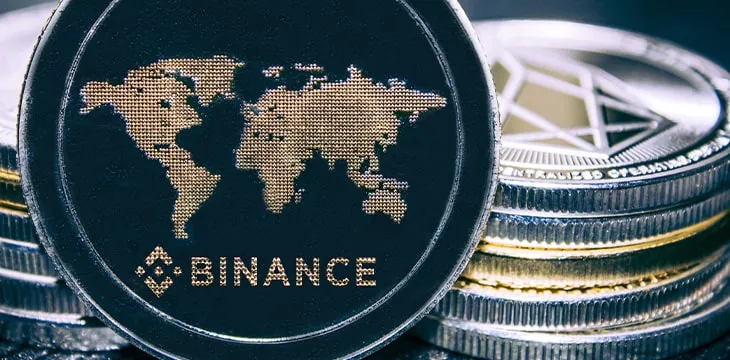|
Getting your Trinity Audio player ready...
|
Binance’s dealings with American hedge funds are under scrutiny by federal authorities just as the controversial digital asset exchange is enduring an unprecedented outflow of customer funds.
This weekend, the Washington Post reported that the U.S. Attorney’s Office for the Western District of Washington had issued subpoenas to multiple investment firms seeking their communications with Binance. While the report emphasized that this step doesn’t guarantee criminal charges are in the offing, it does mean the Department of Justice (DoJ) is drawing a more complete picture of Binance’s lengthy history of illegal activity.
John Ghose, a former DoJ prosecutor specializing in cases targeting the ‘crypto’ sector, said Binance “did not have a reputation of being a responsible exchange.” Ghose theorized that prosecutors are trying to pin down Binance’s violations of the Bank Secrecy Act (BSA). According to Ghose, “if there are U.S. customers, there are charges for avoiding the [BSA’s] money laundering requirements.”
Binance set up a U.S.-registered subsidiary (Binance US) in 2019 as part of a well-organized plan to distract U.S. regulators from ongoing illegality at Binance’s international operation. This includes the likelihood that Binance.com continued to serve U.S. customers in violation of U.S. edicts while reducing ‘friction’ by ignoring requirements to perform adequate ‘know your customer’ (KYC) and anti-money laundering (AML) checks.
Binance’s chief strategy officer Patrick Hillmann declined to comment on the WaPo’s subpoena revelations while offering up the usual malarkey about how there’s nothing Binance founder Changpeng ‘CZ’ Zhao likes better than starting off every morning with a big steaming bowl of compliance.
While the WaPo said U.S. authorities may have difficulty going after Binance due to CZ’s alleged non-involvement with U.S.-facing operations, that façade came (further) undone last month when blockchain sleuths discovered digital wallets funneling billions between Binance US and the international exchange.
While the revelation that the allegedly ‘independent’ companies may be commingling user funds is indeed damning, it’s not like CZ’s been all that stealthy in the past. Binance US is run by BAM Trading Services, a company wholly owned by CZ, and the parade of CEOs that Binance US has had over its brief history suggests that they only stick around as long as they’re willing to say ‘how high’ whenever CZ says ‘jump.’
The incredible shrinking Binance
In November, as fear followed the collapse of the FTX exchange, customers began withdrawing billions from their Binance accounts. On Monday, Forbes reported that this outflow shows no signs of abating, with customers having withdrawn roughly one-quarter of all assets held on the exchange since November. Some estimates put the total net outflow as high as 31%.
Concerns are also increasing about the soundness of the tokens remaining on Binance, including its in-house, printed-out-of-thin-air BNB. Binance released a ‘transparency’ statement in November showing it held around 58 million BNB worth around US$17 billion, but other data firms suggested the number of BNB was actually significantly lower. In Forbes’ estimation, that would mean that “a great portion of Binance’s wealth comes from IOUs of its making sprinkled with crypto pixie dust.”
FTX had its own in-house token, FTT, which it massively overvalued to paper over the gigantic holes on the balance sheet of FTX’s affiliated market-maker Alameda Research. It was CZ’s threat to dump Binance’s over $500 million worth of FTT that ultimately pushed the already teetering FTX over the edge. Small wonder that investors are concerned with any exchange that appears to lean so heavily on digital pet rocks it can conjure up at will.
Then there’s BUSD, the stablecoin that began as a partnership between Binance and Paxos. The Paxos version of BUSD is indeed backed 1:1 with the U.S. dollar, but Binance issues its own version of BUSD on its own BSC/BNB blockchain that takes a more ‘flexible’ approach to maintaining a 1:1 peg with the greenback.
Last week, DataFinnovation issued a report showing that “BUSD on BSC has a history of being significantly unbacked.” The report details the frequency with which Binance “had a lower balance of BUSD than the number circulating on BSC on many, many days in the past.” In short, the Binance-issued BUSD “was often undercollateralized.”
While the Binance-issued BUSD is reportedly (for the moment) back to being fully collateralized, it’s a fact that “unbacked stablecoins were printed and subsequently got backed by some source of funds inconsistent with the stated process. And it is proof the flows through the backing wallets do not make much sense with respect to the process Binance was supposed to follow.”
Moreover, DataFinnovation revealed that the fiat value of BNB soared during periods in which unbacked printing of BUSD occurred. Tellingly, these BNB pumps lost steam when the BUSD printing abated. So, the rules ostensibly governing Binance-issued BUSD aren’t always followed, and Binance’s massive stores of BNB increase in value during these periods of rule-avoidance. Nothing to see here folks, move along…
Mark to marketing
Despite—or more likely because of—all these red flags and regulatory probes, Binance is spending some major green to win hearts and minds on Capitol Hill. Forbes reporter John Hyatt recently detailed how Binance has been sponsoring the Politico Playbook daily newsletter, considered a must-read for Beltway insiders.
The sponsorship is the latest plank in CZ’s plan to claim the ‘crypto good guy’ role recently vacated by FTX’s Sam Bankman-Fried. It also offers Binance the chance to deliver a daily dose of would-be Jedi mind tricks. These include repeatedly attempting to distance Binance from the FTX’s of the world by declaring Binance to be fully committed to “transparency and consumer protection.”
Those claims are thoroughly rebutted by, well, Binance’s very existence. Even if anyone with any clout in Washington was fooled by those Playbook promos, last week’s objections by multiple federal and state agencies to Binance US’s potential acquisition of the assets of bankrupt digital lender Voyager will likely be enough to snap these pols back to reality.
The Texas securities regulator’s objection, in particular, exposes the lies behind Binance’s transparency claims, detailing over a year’s worth of futile attempts to convince (a) CZ to submit personal financial information or (b) Binance US to provide material information about its related parties, without which Binance US couldn’t obtain a money transmitter license in Texas.
(Not so) bon Voyager
On Sunday, Voyager filed replies to these objections with the U.S. Bankruptcy Court. One filing claims that the objections “are based on unverified media reports” and further claims that any questions regarding Binance US’s financial situation “are veiled attempts to override [Voyager’s] business judgment based on speculation as opposed to the facts” and “a naked attempt to undermine the Binance.US Transaction and attack Binance.US.”
The filing notes that, despite the deal for Voyager customers’ assets being advertised as worth $1.022 billion, $1.02 billion of that is the value of the assets that will be transferred to Binance US. The exchange is only putting up $20 million of its own cash, which Voyager insists is well within Binance US’s means to produce.
The other filing states that all the objections “ignore the practical realities of these chapter 11 cases and fail to identify any transaction that provides a better outcome for [Voyager’s] creditors. There is none.”
But these filings are less emphatic when it comes to alleviating concerns that Binance.com might gain access to Voyager customers’ assets once they’re transferred to Binance US – much as the two Binance exchanges are sharing assets via those digital wallets.
As the Texas objection noted, Binance US’s terms of service require users to accept the exchange “having Digital Assets on deposit or with any third-party, including Related Parties, in a custodial relationship that has attendant risks, which include … risk of loss.”
There’s also the fact that the U.S. Committee on Foreign Investment in the United States (CFIUS) is conducting a national security review of the Voyager deal. That announcement, signed by Damian Williams, U.S. Attorney for the Southern District of New York, didn’t mention Binance or CZ by name but the implication is that the government isn’t wild about letting a foreign national with a seriously dodgy reputation gain even indirect control of U.S. customers’ assets.
Voyager says it and Binance US have “engaged” with CFIUS and “plan to make a voluntary CFIUS filing and incorporate responses to CFIUS’ latest requests in such filing.” Voyager also says not to worry, there’s a backup plan to return assets to customers in the event that CFIUS tells Binance to step off.
History may not repeat itself… but it does rhyme
Forbes estimated that Binance’s 2022 decision to eliminate fees on certain BTC trading pairs may have cost the exchange some $3 billion in annual revenue. But by the end of 2022, Binance’s share of the global BTC spot trading volume more than doubled to 92%. While the plan to attract new customers may have worked, customers are now pulling their assets off Binance, creating new problems.
We now know that FTX was pursuing the Voyager assets in the hope that Voyager customers wouldn’t immediately withdraw their assets, which might give FTX some financial wiggle room (for a time, anyway). Encouraging customers to move their BTC to Binance may have simply been a more long-term version of FTX’s bid to retain the perception of solvency, as may be Binance’s dogged pursuit of Voyager’s assets.
Far-fetched? Perhaps. But consider the lengths to which CZ was willing to go late last year to promote a half-baked attestation of certain Binance assets, while providing no information whatsoever on liabilities. CZ’s relentless promotion of this ‘proof of nothing’ as a proper third-party audit led the third-party in question (Mazars) to issue a statement denying CZ’s claims, scrub the report from its website and eventually get out of the crypto attestation business entirely.
Ask yourself: how bad does your real financial situation have to be to risk such a blatant PR self-own? Now ask yourself another question: how might all this crypto nonsense end? Probably much like it’s been going so far…
Follow CoinGeek’s Crypto Crime Cartel series, which delves into the stream of groups—from BitMEX to Binance, Bitcoin.com, Blockstream, ShapeShift, Coinbase, Ripple,
Ethereum, FTX and Tether—who have co-opted the digital asset revolution and turned the industry into a minefield for naïve (and even experienced) players in the market.

 03-31-2025
03-31-2025 





